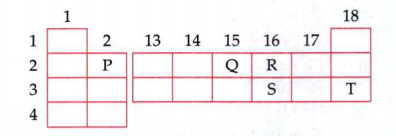Three elements P Q and R have consecutive increasing atomic numbers. lf Q is a noble gas then which of the following is correct about P and R? A P and R belong to the same period of the periodic table. B P is a non-metal while R is a metal. C P and R belong to same group of the periodic table. D None of these
Correct option B P is a non-metal while R is a metal. Explanation: P Q and R have consecutive increasing atomic numbers. As noble gases are present at the end of each period P must be a non-metal of the same period and R must be a metal of the next period.
Related Solutions
The atomic number of elements P, Q, R, S and T are given. Which element belongs to 3rd period of periodic table?
View SolutionThe positions of three elements P, Q and R in the periodic table are shown below

Which of these three elements is most non-metallic ?View SolutionThe table given below shows the mass number and number of neutrons in four elements P, Q To which periods do P, Q, R and S belong?
View SolutionA part of periodic table is shown in the following figure
 Arrange elements 'P',Q' and 'R' in increasing order of their metallic character.View Solution
Arrange elements 'P',Q' and 'R' in increasing order of their metallic character.View SolutionThree elements P, Q, and R have successive atomic numbers with same period . If P > R > Q in terms atomic size. Predict the group of each element. Give reason.
View SolutionElement P has atomic number 19. To which group and period, does P belong? Is it a metal or a non- metal ? Why?
View SolutionElement P has atomic number 19. To which group and period does P belong? It is a metal or a non metal ? Why?
View SolutionIf P, Q, R and S are elements of 3rd period of p-block in modern periodic table, among these one element is metal and rest are non-metals and their order of electronegativity is given as:
Q. Chloride compound of which element is hypovalent?View SolutionIf P, Q, R and S are elements of 3rd period of p-block in modern periodic table, among these one element is metal and rest are non-metals and their order of electronegativity is given as:
Q. Chloride compound of which element is hypovalent?View SolutionIf P, Q, R and S are elements of 3rd period of p-block in modern periodic table, among these one element is metal and rest are non-metals and their order of electronegativity is given as: P lt Q lt R lt S Q. Chloride compound of which element is hypovalent?
View SolutionIf P, Q, R and S are elements of 3rd period of p-block in modern periodic table, among these one element is metal and rest are non-metals and their order of electronegativity is given as:
Q. Chloride compound of which element is hypovalent?View SolutionIf P, Q, R and S are elements of 3rd period of p-block in modern periodic table, among these one element is metal and rest are non-metals and their order of electronegativity is given as:
In which of the following linkage release of is relatively more easier?View SolutionIf P, Q, R and S are elements of 3rd period of p-block in modern periodic table, among these one element is metal and rest are non-metals and their order of electronegativity is given as:
In which of the following linkage release of is relatively more easier?View SolutionIf P, Q, R and S are elements of 3rd period of p-block in modern periodic table, among these one element is metal and rest are non-metals and their order of electronegativity is given as:
Which element is expected to form amphoteric oxide?View SolutionIf P, Q, R and S are elements of 3rd period of p-block in modern periodic table, among these one element is metal and rest are non-metals and their order of electronegativity is given as:
Which element is expected to form amphoteric oxide?View SolutionIf P, Q, R and S are elements of 3rd period of p-block in modern periodic table, among these one element is metal and rest are non-metals and their order of electronegativity is given as: P lt Q lt R lt S Q.
View SolutionIf P, Q, R and S are elements of 3rd period of p-block in modern periodic table, among these one element is metal and rest are non-metals and their order of electronegativity is given as:
Which element is expected to form amphoteric oxide?View SolutionConstruct the truth table for the followings statements :
(a)
(c)View SolutionConstruct the truth table for the followings statements :
(a)
(c)View SolutionConstruct the truth table for the followings statements :
(a)
(c)View Solution
